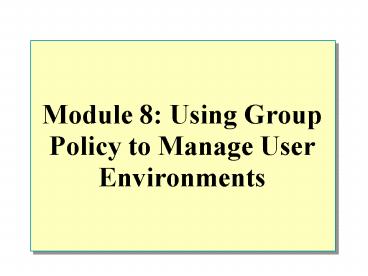Module 8: Using Group Policy to Manage User Environments - PowerPoint PPT Presentation
1 / 29
Title:
Module 8: Using Group Policy to Manage User Environments
Description:
Settings for Locking Down the Desktop. Hide all icons on desktop. Don't save settings at exit ... My Network Places icon on desktop. Remove the 'Map Network ... – PowerPoint PPT presentation
Number of Views:153
Avg rating:3.0/5.0
Title: Module 8: Using Group Policy to Manage User Environments
1
Module 8 Using Group Policy to Manage User
Environments
2
Overview
- Introduction to Managing User Environments
- Introduction to Administrative Templates
- Using Administrative Templates in Group Policy
- Assigning Scripts with Group Policy
- Using Group Policy to Redirect Folders
- Using Group Policy to Secure the User Environment
- Troubleshooting User Environment Management
- Best Practices
3
Introduction to Managing User Environments
- Control What Users Can Do in Their Environments
- Use Group Policy Settings to Control User
Environments - Apply Group Policy to a Container to Immediately
Define a User Environment for a New User or
Computer
- Configure and Centrally Manage User Environments
- Enforce standard configurations
- Limit user access to portions of the operating
system - Ensure that users always have their data
- Restrict the use of Windows 2000 tools and
components - Populate user desktops
- Secure the user environment
4
Introduction to Administrative Templates
- What Are Administrative Templates?
- How Computers Apply Administrative Template
Settings
5
What Are Administrative Templates?
- Administrative Template Settings Modify Registry
Settings That Control User Environments - Settings Modify Registry Settings in the Registry
Subtrees - HKEY_LOCAL_MACHINE for computer settings
- HKEY_CURRENT_USER for user settings
- If a GPO No Longer Applies, Policy Settings Are
Removed - Windows 2000 Applies Both Group Policy and Local
Default-Registry Settings Unless There Is a
Conflict
6
How Computers Apply Administrative Template
Settings
7
Using Administrative Templates in Group Policy
- Types of Administrative Template Settings
- Settings for Locking Down the Desktop
- Settings for Locking Down User Access to Network
Resources - Settings for Locking Down User Access to
Administrative Tools and Applications - The Loopback Processing Mode Setting in Group
Policy - Implementing Administrative Templates
8
Types of Administrative Template Settings
9
Settings for Locking Down the Desktop
Group Policy Settings to Lock Down the Desktop
- Hide all icons on desktop
- Dont save settings at exit
- Hide these specified drives in My Computer
- Remove Run menu from Start menu
- Prohibit user from running Display control panel
- Disable and remove links to Windows Update
- Disable changes to Taskbar and Start Menu
settings - Disable/Remove the Shut Down command
10
Settings for Locking Down User Access to Network
Resources
11
Settings for Locking Down User Access to
Administrative Tools and Applications
12
The Loopback Processing Mode Setting in Group
Policy
The Loopback Processing Mode Setting
- Applies Configuration Settings to Computers
- Is Used for Computers Dedicated to Specific Tasks
- Can Either Be Set to Either Replace Mode or Merge
Mode
- The
13
Implementing Administrative Templates
- Selecting One of the Three States Configures a
Setting
- Configuring the Same Setting Differently in
Different GPOs Creates Conflicts
14
Lab A Using Administrative Templates to Assign
Registry-Based Group Policy
15
Assigning Scripts with Group Policy
- What Are Group Policy Script Settings?
- The Process of Applying Script Settings with
Group Policy - Assigning Group Policy Script Settings
16
What Are Group Policy Script Settings?
- Group Policy Script Settings Allow You to
- Centrally Configure Scripts to Run Automatically
at Startup and Shutdown, and When Users Log On
and Log Off - Manage and Configure User Environments
17
The Process of Applying Script Settings with
Group Policy
18
Assigning Group Policy Script Settings
19
Lab B Using Group Policy to Assign Scripts to
Users and Computers
20
Using Group Policy to Redirect Folders
- What Is Folder Redirection?
- Selecting the Folders to Redirect
- Redirecting Folders to a Server Location
21
What Is Folder Redirection?
- Advantages of Folder Redirection
- Data Is Always Available to Users Regardless of
the Computer Logged on to - Data Is Centrally Stored for Ease of Management
and Backup - Network Traffic Is Generated Only When Users Gain
Access to Files - Files Are Not Saved on the Client Computer
22
Selecting the Folders to Redirect
23
Redirecting Folders to a Server Location
24
Lab C Implementing Folder Redirection Policy
25
Using Group Policy to Secure the User Environment
26
Lab D Implementing Security Settings by Using
Group Policy
27
Troubleshooting User Environment Management
Registry Settings Are Not Applied
Scripts Do Not Execute
Folders Are Not Being Redirected
28
Best Practices
Create a Minimal Number of GPOs Required
Place All Computers Affected by Loopback in the
Same OU
Always Test the Effects of Administrative
Template Settings
Make Sure That Scripts Run in the Preferred Order
Always Redirect the My Documents Folders
29
Review
- Introduction to Managing User Environments
- Introduction to Administrative Templates
- Using Administrative Templates in Group Policy
- Assigning Scripts with Group Policy
- Using Group Policy to Redirect Folders
- Using Group Policy to Secure the User Environment
- Troubleshooting User Environment Management
- Best Practices































